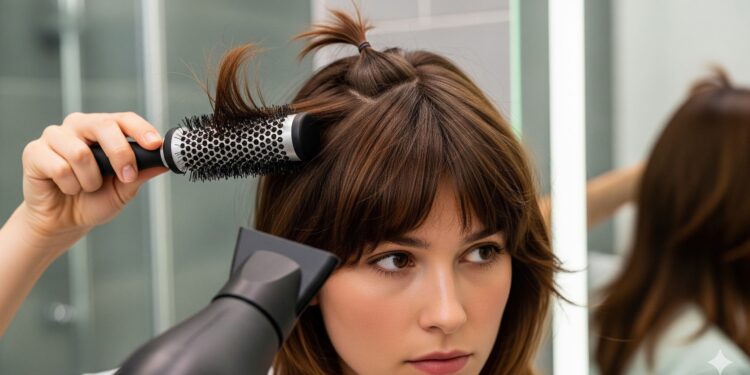A fringe can change your entire look—it frames the face, adds personality, and gives your hairstyle that little bit of drama. But if you’ve ever had a textured fringe (the kind with movement and layers instead of a blunt cut), you know one challenge always shows up: keeping it full and bouncy instead of flat and lifeless.
That’s where blow-drying hacks come in. The right technique with your dryer can add volume, prevent separation, and make your textured fringe sit perfectly all day. In this guide, I’ll walk you through simple but game-changing tricks to master the art of blow-drying your fringe.
I’ve also included a few personal experiences, common mistakes to avoid, and pro tips I’ve picked up from hairstylists. Whether your hair is fine, thick, wavy, or straight, you’ll find something here that works for you.
Why Volume Matters for a Textured Fringe
Volume isn’t just about “big hair”—it’s about balance. A textured fringe is meant to look light, airy, and full of movement. Without volume, it tends to stick flat against the forehead or separate into awkward chunks.
When you add volume:
- Your face looks more open and fresh.
- The fringe blends seamlessly with the rest of your hairstyle.
- It lasts longer through the day without touch-ups.
I still remember the first time I had my fringe cut into a choppy, textured style. It looked amazing when I left the salon, but the next morning I woke up to what looked like two greasy strings hanging over my forehead. That’s when I realized—styling makes or breaks a fringe. Blow-drying changed everything.
Essential Tools for Blow-Drying Your Fringe
Before diving into hacks, let’s quickly talk about what you’ll need. The tools matter just as much as the technique.
- Hairdryer with nozzle attachment – The nozzle directs airflow so you don’t just blast heat everywhere.
- Round brush or vented brush – Round brushes help create lift; vented brushes speed up drying.
- Clips – To hold back the rest of your hair so you can focus on the fringe.
- Heat protectant spray – Never skip this. A fringe sits right on your face, so it’s the first thing people notice. Damaged fringe = bad day.
- Lightweight volumizing mousse or spray – This gives grip without weighing down.
Step-by-Step Blow-Drying Hacks for Extra Volume
Here’s the main part you’ve been waiting for—practical hacks to blow-dry your textured fringe with long-lasting lift.
1. Start with Damp, Not Soaking Wet Hair
Don’t start blow-drying when your hair is dripping. Instead, towel-dry or let it air dry until it’s about 70% dry. That way, you’ll avoid frizz while still having enough moisture to shape your fringe.
2. Blow-Dry Against the Grain
One of the oldest tricks in the hairstylist’s book is drying in the opposite direction of how your hair naturally falls.
- If your fringe tends to split down the middle, blow-dry it side-to-side.
- If it sits flat, lift it upwards with a brush while drying.
By forcing the roots in different directions, you create natural volume once the fringe falls back into place.
3. Use the Nozzle and Low Heat Setting
High heat can make your fringe limp or frizzy. Instead, use medium heat with the nozzle aimed downward along the hair shaft. This smooths the cuticle while still letting you create lift at the roots.
4. The Roll-and-Cool Method
This is my favorite hack (and one I use almost every day).
- Wrap your fringe around a round brush.
- Blow-dry it for 10–15 seconds.
- Keep it wrapped and blast it with the cool shot button.
The cool air “sets” the shape and locks in the bounce. When you release the brush, the fringe naturally springs forward with volume.
5. Finger-Lift at the Roots
If you don’t want to fuss with brushes, here’s a lazy but effective method:
- Use your fingers to lift your fringe at the roots.
- Aim the dryer from underneath for a few seconds.
- Let it fall naturally.
This adds airy lift without too much effort—perfect if you’re running late.
6. Dry in Small Sections
Instead of trying to dry your entire fringe in one go, split it into two or three smaller sections. This gives you more control and ensures that every piece gets the same amount of volume.
7. Finish with a Blast of Cold Air
Always end with a few seconds of cool air. This closes the cuticle, sets the style, and prevents your fringe from going flat five minutes later.
Extra Tricks for Different Hair Types
Your hair type plays a big role in how your fringe behaves. Here’s how to adjust your blow-drying routine:
- Fine Hair: Use a lightweight mousse or root spray before drying. Avoid heavy creams or oils.
- Thick Hair: Blow-dry in smaller sections with medium heat to avoid bulk.
- Wavy/Curly Hair: Use a diffuser attachment on low heat to keep natural texture intact.
- Oily Hair: Sprinkle dry shampoo at the roots before blow-drying—it adds grip and keeps the fringe fresh.
Common Mistakes to Avoid
I’ve made most of these mistakes myself, so trust me when I say they’re worth avoiding:
- Drying the fringe last – By the time you get to it, the fringe has already dried in its natural (usually flat) shape. Always dry it first.
- Using too much product – It’ll weigh your fringe down. Start light; you can always add more later.
- Skipping the nozzle – Without it, the airflow makes hair frizz instead of smooth.
- Not setting with cold air – This is the step that keeps volume lasting longer.
Long-Lasting Volume Tips
Once your fringe looks great, you’ll want it to last all day. Here are a few hacks for staying power:
- Sleep with a silk pillowcase—it reduces friction and keeps your fringe smooth.
- Carry a mini dry shampoo in your bag for mid-day touch-ups.
- If your fringe starts to separate, run your fingers through it and blast it with cold air for a quick reset.
Personal Story: My “Flat Fringe” Problem
I’ll admit—when I first got a textured fringe, I regretted it within two days. My fine hair would flatten within an hour of styling, no matter what I tried. But then a hairstylist friend told me: “You’re not drying it right. The fringe decides its shape while it’s wet.”
That advice changed everything. Now, I spend literally three minutes drying my fringe after a shower, and it stays in place the whole day. I can’t say the same for my eyeliner, but at least my hair behaves.
Professional Stylist Insights
I reached out to a hairstylist friend for her go-to trick. Here’s what she said:
“Most people treat their fringe like an afterthought, but it’s actually the most important part of the hairstyle because it frames your face. The trick is to blow-dry it immediately after washing, before it starts to air-dry. That’s when you have the most control.”
She also mentioned that alternating the direction while drying helps prevent cowlicks and adds fullness.
FAQs: Blow-Drying Hacks for Textured Fringe
Q1. Should I always blow-dry my fringe?
Yes. Blow-drying gives you more control and volume. If you let it air-dry, it usually sits flat, separates, or highlights cowlicks.
Q2. How long does it take to blow-dry a fringe?
Only 2–4 minutes. Since your fringe is a small section, it’s the quickest part to style but makes the biggest difference to your look.
Q3. Can I use a straightener instead of a blow-dryer?
You can, but it’s not ideal. Straighteners often make fringes look too flat and stiff, while a blow-dryer adds softness and natural lift.
Q4. What products should I use before blow-drying?
A heat protectant spray and a light volumizing mousse are the best options. They protect your hair and give your fringe the grip it needs without weighing it down.
Q5. How do I fix a fringe that keeps separating?
Blow-dry side-to-side while lifting at the roots. This helps break up natural partings. A light texturizing spray also keeps strands together.
Q6. Is it possible to blow-dry a fringe without a round brush?
Yes, you can use your fingers or a vented paddle brush. Lifting your fringe at the roots with your hands while drying is a quick, easy alternative for added volume.





